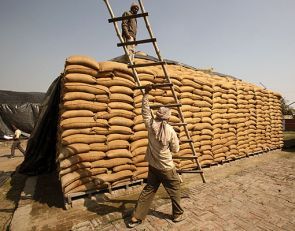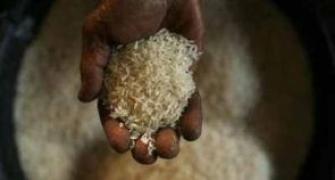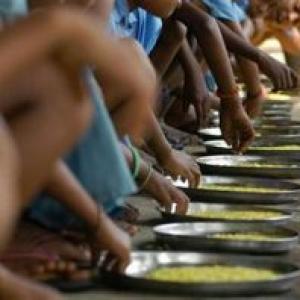 Implementing the Food Ordinance is the bigger challenge and there are many provisions of the National Food Security Bill which need to be expanded and strengthened.
Implementing the Food Ordinance is the bigger challenge and there are many provisions of the National Food Security Bill which need to be expanded and strengthened.
Biraj Patnaik, principal adviser to the Food Commissioner appointed by the Supreme Court, speaks to Sreelatha Menon.
Would you call the Ordinance the end of the struggle for the Right to Food movement and a successful one though it has come as an ordinance?
The Right to Food campaign sees this as the beginning of the struggle rather than the end of it.
There are many provisions of the National Food Security Bill which will need to be expanded and strengthened.
For instance, the reduction of entitlement of foodgrains to 25 kg from the existing 35 kg is clearly unacceptable.
The non-inclusion of millets and oil in the public distribution system; the potential backdoor entry of contractors in the Integrated Child Development Scheme; the fact that farmers have been completely left out of the Bill; the reduction of the entitlements for children; the exclusion of other key determinants of nutrition like sanitation and safe drinking water and the removal of community kitchens and destitute persons from the final version of the ordinance/Bill are also important omissions that need to be addressed.
The RTF campaign was hoping that many of these provisions would be addressed by the amendments that the political parties have introduced and, therefore, a debate in Parliament is critical for the NFSB.
We are, therefore, deeply disappointed that the government is adopting the ordinance route for what is potentially a historic legislation.
Even if all these were to be incorporated in the NFSB, getting the Act implemented and ensuring that people get their entitlements on the ground will remain the main challenge for the campaign.
By far the biggest challenge will be the correct identification of the poor.
The experience of the RTF campaign has been that whenever there has been targeting, it has led to exclusions.
And the most vulnerable sections of the population, who need the benefits of the legislation, are the ones who are likely to be left out.
In a nutshell, the Ordinance is a small step in the right direction, but much more needs to be done.
While 59 million tonnes (mt) of food grains are being procured for PDS annually, the new law would require 61 mt, just an additional 3 mt. So should one worry about shortages like in 2003?
You are absolutely right that the requirement of food grains is not much to worry about.
The procurement in the past three years is a pointer to future procurement trends and I think many of the apprehensions that are being raised are not based on facts.
In any case, I don’t think we can plan based on the absolute worst case scenarios because the assumption that most economists are making is that 100 per cent of the eligible population will be accessing their Right to Food.
This is unlikely the case and is not supported by evidence from the states which have universalised their PDS like Tamil Nadu, where the offtake is around 80 per cent or so.
Since only an additional 3 mt of food grains are to flow into the system, what according to you, is the change that the Ordinance brings, apart from making it a legal entitlement? Do you think it was clever of the government to gain so much impact on the poor by spending very little extra, and actually reducing the amount of food grains?
I think the major change that will happen is two-fold.
The removal of the poverty line will ensure that allocations for food grains to the state governments will go up.
The poorer states stand to benefit the most from it since in some cases, they will now have coverage of close to 90 per cent. More importantly, in the states which have already expanded their PDS, a major share of the additional expenditure that they were incurring will now be borne by the Central government.
Barring very few states, most governments gain hugely, both in terms of food grain allocations and in additional fiscal support.
As far as taking credit is concerned, state governments are likely to be more clever than the government of India by spending even less and taking credit for it.
Which is all for the good since if it is implemented properly, the poor will stand to gain the most in this tussle for credit between the state and the Centre.
So far, states have been refusing to lift food grains for PDS. So in Uttar Pradesh, for instance, as little as 12 per cent was being lifted. Do you think the law would force UP or other states to lift the full supply and compulsorily distribute or fear public-interest litigations from people or activists like you?
That is just not true, offtake from the PDS is actually quite high now and almost 100 per cent for Antodaya beneficiaries and quite high similarly for the below poverty line families.
The only category where offtake by states sees a wide variation is the above poverty line category.
Offtake in APL is contingent on market prices and given the price volatility of foodgrains in recent times, the offtake has also varied widely.
Courts will remain the last resorts and they will be reticent to step in when legislation is in place.
Especially so, when the legislation has a grievance redressal mechanism built into the Act to ensure that entitlements reach people.
Courts will step in only after all the avenues of redressal given within the Act have been exhausted.
This apprehension of large-scale litigation was raised even when the National Rural Guarantee Scheme was launched and many bureaucrats and policymakers had raised this apprehension that the courts will be flooded with applications for relief.
But that did not happen.
Mostly because access to justice remains a distant dream for most people who are too poor to afford the costs of litigation.
Some question the fact that while 29 per cent of the population is supposed to be BPL, the new law would make 67 per cent eligible for the scheme. What justifies the 67 per cent?
The BPL, as it stands now, is 36 per cent (based on the Supreme Court orders) that is based on a minimalist poverty line which by the Planning Commission’s own admission is a ‘destitution line’ and a ‘rock-bottom existence’.
This should be seen as a long overdue correction and a much-needed one.
It is an admission of the failure of the reforms-led growth model that we have been pursuing since the early 1990s that has led to a situation where a fifth of our urban population and more than a third of our rural population leads a rock-bottom, subsistence level existence.
In urban areas, 50 per cent of the population is excluded. But most migrants who live in urban areas wont benefit as their cards are in the villages. So can they sue the government and ask for roaming ration cards? Or sue the government for denying them ration cards and asking for local identity cards?
There are two main conditions that need to be fulfilled if migrants are to be guaranteed of their Right to Food: a fully computerised system that is given online, real time data on individual offtake, connected to a national grid and a credible system of last mile authentication, ie a fool-proof system of correctly identifying the beneficiary.
If this were to be achieved, we can ensure full ‘entitlement portability’.










